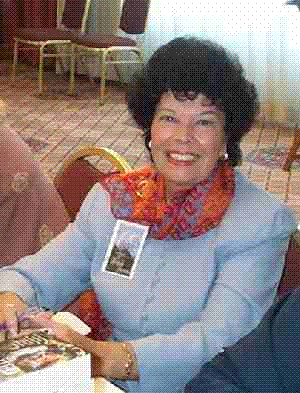

Virginia Henley is a genius. Her plots
are
always unique, refreshing and
exciting.
From the moment her protagonists step on
stage, her readers are in awe.
RAVISHED is another gem in her literary tiara.
- Rendezvous
Virginia Henley delivers just what her
readers
expect; a fast-paced, sensual read.
This time she goes one step further by giving us
two roguish men and one utterly delightful heroine.
The pages sizzle as we're swept up in a tale
brimming over with wit, mayhem and a great deal
of poignancy. (A Top Pick!)
- Kathe Robin, Romantic Times
I'm always quite proud of the reviews that I get, and thought I'd pass them along for you to read. All my best -- Always. Virginia.
Notorious Review:
"No one sets fire to the page like Virginia Henley," raves Christina Skye. In NOTORIOUS the New York Times bestselling author returns to medieval England to tell the story of Brianna de Beauchamp, the daughter of one of the most intriguing women in all of England...
Signet Eclipse, 2011
When it comes to reading steamy historical romance novels, one of the very first hopes readers are expected to abandon is any kind of working verisimilitude. Instead, they must steel themselves for a veritable Noah’s Ark of anachronisms. Highlanders will wear tartan kilts. Regency rakes will have clean teeth and hair. Louisiana bayou ‘bad boys’ will have parents who aren’t brother and sister. Prodigies will abound, for all the world as though history – actual history – weren’t already the most fascinating place any reader could ever visit.
Knowing this and wearily accepting it (those of us who regularly read historical romances have received far too much enjoyment from the sub-genre over the years to simply drop it), readers might look at the cover of Virginia Henley’s new novel The Dark Earl and fear the worst, especially if they read the book’s back cover, which talks about the Earls of Lichfield and their ancestral home of Shugborough Hall. The first reaction is to glance back at the cover again and sigh in dismay: not only is that not Shugborough Hall in the background (the place is marvellously distinctive, after all – you’re urged to drive out and visit it, when next your in the area), but that picture of what we can presume is the title character … such a picture! It’s popular cover-model Paul Marron at his most sultry, with carefully moussed hair and lovingly tended abs, as thoroughly a creature of the 21st century as possible. Even if we’re hazy on the particulars of 1854 England, we can be confident in believing no young man anywhere in the country looked like that.
As worrying as the cover is, however, one thing no romance reader would assume is that the cover is the most inaccurate thing about the book. Usually, a catalogue of horrors far worse await inside the book.
So it’s with a great deal of pleasure that I report: There are virtually no invented characters in this book, and almost all of its history is entirely accurate. These are things that can’t even be said of most mainstream historical novels. True, Henley has played a bit fast and loose with hereditary titles (but not, as is usually the case in genre novels, through ignorance – Henley was born in England, and as Anthony Trollope tells us when discussing hereditary titles, “They who are brought up among it, learn it as children do a language”), but readers familiar with the late Georgan/early Victoria period will be very pleasantly surprised at how little else is out of place. The book is about the headstrong young heir to the impoverished Earl of Lichfield, Thomas Anson, and his high-spirited courtship with Lady Harriet “Harry” Hamilton, and both the Anson and the Hamilton clans are here in all their chatty multitudes, with nary an imaginary “Earl of Kimbalton” or “Viscount Sedgewick” in sight. Even the throw-away details are usually correct; when we’re told in one scene, for instance, that the Duchess of Buccleuch was Queen Victoria’s Mistress of Robes for five years (or that Harry’s father had been lord lieutenant of Donegal), we’re told true. Readers of Henley’s historical romances are accustomed to her higher-than-usual degree of veracity, but even so: I suspect this degree is unprecedented in the genre. It lays the whole of British aristocratic history open for lightly fictionalized rendition, and it makes Burke’s Peerage into a Holinshed hunting-ground of dramatic potential.
Inside her framework of fact, Henley tells a winsome enough story (in her evocation of these long-ago grandees’ motives and passions – let alone their dialogue – our author is of course making things up left, right, and center, with the practiced hands of an old pro): outspoken and unconventional “Harry” Hamilton and embarrassed Lichfield heir Viscount Anson meet cute when they’re both very young and then, years later, encounter each other again and fall in love. A less practiced author than Henley would be undone by the very factual accuracy she’s gone to such pains to establish, since a glance at the aforementioned Burke’s will tell any curious reader whether or not our young couple eventually find wedded bliss together. To her credit, Henley couldn’t be less worried about such things: she’s too busy filling her pages with the kind of effervescent shimmer she can often create so well. On page after page, we are eavesdropping on the privileged while they banter with each other:
Abercorn was one of the men talking to Buccleuch. She [Harry] curtsied prettily to her host and stood on tiptoe to kiss her father. “Did you hear the one about the Irishman and the Scot who walked into a tavern and -”
Walter Montagu, whose brogue was far thicker than his son’s, threw back his head and roared with laughter, while her father’s eyes twinkled at her jest.
“She’s a right saucy lassie, James. If I were ten years younger, I’d be chasin’ her.”
“And I’d let you catch me, your Grace.”
Abercorn greeted his wife. “Hello, darling. You look ravishing tonight.”
“Does that mean you’ll be coming home with me?” she asked with mock alarm.
“Would that be inconvenient?” he asked.
“Well, you know what the French say: Marriage is so difficult, it takes three to make it work.”
The tone of that excerpt is by no means misleading – despite its ominous title, The Dark Earl is a very sunlit book, full of warmth and laughter and hardly any of the brooding passions that can make so many Romance novels so crushingly dull. Thomas Anson’s worldly pursuits – recouping the losses incurred by his father’s insolvency – are always close enough to the forefront of the action to be an entirely believable axis of the plot, and the love that brings our hero and heroine together is most certainly not the fates-and-faeries kind found in so many genre novels. In one of the book’s most charming scenes, we’re treated to a deceptively simple dramatization of how two young people might go about making a Spanish omelette in a Victorian-era kitchen – and how they might top it off with some impromptu pears flambe:
“I won’t deprive you of the fun part. Set the brandy alight and jump back.”
Her eyes were bright as the flame she wielded. “Keep that bucket of sand handy!” She set the pan aflame and hopped back. When the blue flame stopped burning, she divided the concoction into two dessert bowls and anointed them with a dollop of cream.
This time Thomas sat down at the table and pulled her into his lap. “This is the way dessert a deux must be eaten.” Laughing like children, they fed each other and licked their lips between kisses.
The Dark Earl is exactly this kind of tasty, light-hearted treat – fortified with generous helpings of very conscientious historical research. Henley has been an institution for a long time (she dedicates the book to a great-granddaughter), but she’s doing her best work right now. This book should earn her free admission to Shugborough for life.